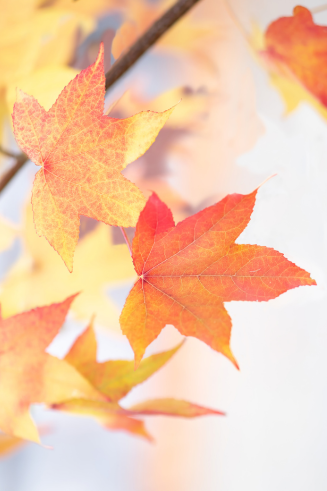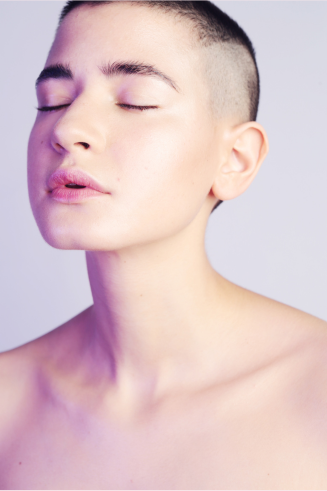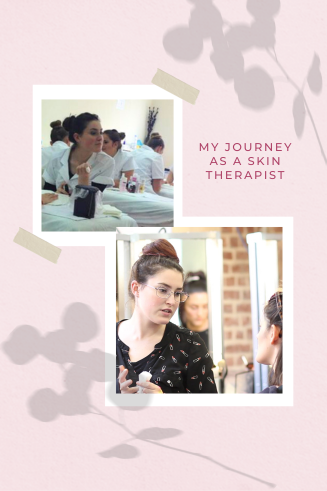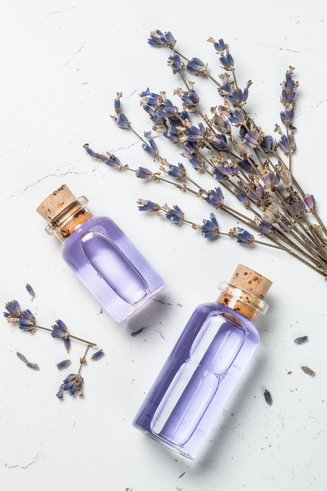Part 2 : "The Clean Beauty Revolution: Why It's More Than Just a Trend"
“Clean beauty“ may seem like the new “in-word“ of the industry, yet many believe, myself included, that it’s a slow, conscious revolution that started years ago without anyone noticing.
A lot of components go into figuring out the impact of our skincare routine or beauty habits on our health and also on the planet.
For a lot of us, the fact that our shower gel, hair dyes, mascara or clothing can impact the groundwater of the country they were made in is unfathomable. I used to be clueless on the matter too. It wasn’t even on my radar. Until I became a mum and I did my research and realized how much everything is interconnected and how much the butterfly effect is real.
That is one of the reasons I dove into Clean Beauty. Because the clean aspect of it doesn’t stop at using products that are non-toxic for humans. I want my son to still be able, when I am gone, to go walk in forests, to see a blue sky, to associate the sound of rain with soothing-ness instead of a high flooding risk, …
Thankfully, the awareness of this issue is starting to grow and with it, so is the Clean Beauty Revolution.
Before we dive in, let’s all get on the same page. Clean beauty means that the products are made with ingredients that are safe for us humans but also for the environment. It also stands for transparency about their sourcing and manufacturing practices as well as ethical and sustainable marketing techniques.
A lot of my clients had decided to forgo most beauty products because finding sustainable options was in the (way) too hard basket. I am happy to now be in a position where I breach the gap and do the research for them. If you’re still unaware of the whys and how your beauty routine and habits should be values-led, read on…Let’s have a look at the impacts that our personal care products can have:
The Impact of Personal Care Products on Health
One of the biggest issue of the industry is that it can take years to determine and study whether or not an ingredient is safe to use without long-term health impact.
According to Harvard Health Publishing, the average woman uses 12 different beauty products daily and chemical exposure adds up.
Yet, with the new technologies and the economic conjuncture based on profits that capitalism put in place, it’s a too fast-paced system… Many companies do not have the luxury of running tests for years before going to market.
If you’re reading this and thinking that no, the quantities are minimal and products that can harm us wouldn’t simply be allowed to be sold, here’s a fact for you: We have all heard the saying “we don’t know what we don’t know”. This is acutely true for the beauty industry.
You may or may not know that Queen Elizabeth the FIRST used Venitian Ceruse on her skin. It was her “foundation” but was made from lead and vinegar. It damaged her skin and to cover it up, she used more of it as years went on… her makeup removal process allegedly included Mercury, and her lipstick contained mercury too. It is believed that her makeup played a part in her frail health at the end of her life.
We now know how toxic mercury and lead are and they have been banned from use in personal care products in some countries.
Now, this was in the 15th century and we know better but… do we? Does the whole world know it? Not quite. There are studies, in 2022, that show that over 99% of the cosmetics lip products and externally applied cosmetics on the U.S. market contain lead at levels below 10 ppm.
Now this concentration may not be high enough to have impact with the first exposure but, “It is a cumulative toxicant that affects multiple body systems, including the neurological, haematological, gastrointestinal, cardiovascular and renal systems.” Bringing us back to : Exposure adds up.
Let’s talk about another example that isn’t as extreme as in isn’t in the 15th Century: Parabens
Parabens have been used in products since the 1920s as preservatives. They prevent micro-organisms, fungus etc.. from developing in personal care products. It’s the reason they don’t need to be stored in the fridge anymore. Yet, studies have shown that some parabens can act in our bodies as oestrogen hormones and cause Endocrine disruption and reproductive harm. Yet, many big companies still use parabens today in their products.
These are just two examples but there are hundreds more. From carcinogenic and hormonal disruption to epigenetic effects, ingredients contained in everyday skincare and makeup can be more harmful longer term than initially made out to be.
What makes me believe that things are on the move in the right direction (although the FDA seems to be a bit behind with still banning only 9 ingredients), is that last year, the European Union announced the largest-ever ban on toxic chemicals. The European Environmental Bureau estimates that roughly 5,000 to 7,000 chemicals will be banned by 2030, compared to the approximately 2000 currently banned ingredients.
It is also becoming more common for manufacturers and beauty professionals to have lists of ingredients they will not use. Some good examples of that are the “Dirty List” from credo beauty and the “No Go List” available on my website. My list is a work in progress as it takes me hours to read studies, gather the sources, and write the bibliography, … Behind the scenes, my actual list includes over 90 ingredients, with only 15 yet visible to the public.
Another outstanding place to have a look is also the EWG website which has a scale to rate toxicity of a product.
These are all signs of changes in the right direction, with good reasons to hope.
On top of the impact on our health, the personal care industry is a GIANT when it comes to its impact on the environment.
The Impact of Personal Care Products on the Environment
This is from a BBC article and it encompasses the issue better than I could write.
“Every formulation is a compromise between price, effectiveness, aesthetics, performance and ethics. It’s a trade-off in which the environment often loses out.”
From the way raw goods are cultivated or mined or farmed, and I am not just talking about the known big problematic ones here like palm oil, to the way they are harvested, transported, packaged and then transformed, all of that impacts the planet and it is just the first step onto a ladder made of hundreds of steps.
Then comes formulations, testing (animal testing anyone?), packaging, marketing, shipping, waste and water usage. Wow… just writing that feels heavy, imagine how heavy all these add up to for our ecosystem? Let’s just dive a bit deeper on one of these issues:
Clean beauty products often belong to the slow cosmetics category. This means they aren’t mass-manufactured and are made in small batches by a business owner who feels responsible: Most of us who are aware of the environmental issue in the business industry who open a business feel the weight of the world on our shoulders and carry extensive environmental guilt. This means that we do our absolute best to find a compromise between what we can do that is responsible and what we can afford.
A great way small skincare businesses do this is through a circular system/economy.
An outstanding great example of this is Dust and Glow. The founder, Gaëlle Thieme teamed up with Circularity NZ to come up with a closed-loop system:
- Products are waterless, protecting our most valuable asset on Earth: Water and because of this, they don’t require preservatives.
- Products are vegan, cruelty-free and naturally derived with raw materials that are traceable.
- The range is made in limited numbers and packaged in 100% plastic-free, endlessly recyclable aluminium bottles.
- Labels are made from natural limestone waste.
- CO2 emissions have been kept in mind and minimised all the way through production.
- Gaëlle closes the loop nicely by selling refills for the entire range in certified home compostable packaging as well as offering a take-back program with free shipping.
When a consumer supports brands like Dust and Glow, it sends a message to the industry, and that message is finally being heard.
The often-overlooked impact of Personal Care Products on the financial systems
By switching to clean beauty products, we lighten some load of the financial system. To only talk about one example, it’s an understatement to say that the amount of people sick with cancer is on the rise. It is true that tests are run more frequently and earlier, so more people as screened but, in fact. The number of people who died from cancer increased by 75% in 30 years (yes, you read that right).
Depending on where you live, the government supports and health insurance etc.. are different.. As an example, New Zealand spends $130m annually (gross cost) on its cancer medicines, Most places offer financial support or some form of counselling, health support and/or transportation support to aid cancer patients and their families. It is, excuses my French, fucking necessary for these to be funded, but could we also focus on the cause instead of simply dealing with the consequences? Because just like hyperpigmentation after a laser treatment or a lick of paint on mould, if you only treat the symptoms or the consequences and not the cause, the issue will only get worse.
By switching to clean beauty and having more regulations in place, we lessen the load on our bodies when they are exposed to non-toxic chemicals (whether in our cosmetics OR in our environment) in turn, long-term, we stay healthy longer and thus, not needing to government supports for cancer patients.
I could go on and talk about transportation, and the time impact it has on all our lives because of the density of traffic, the amount of waste generated with packaging etc… but I believe you now know what I mean by:
So think about where your money goes and look into the companies you support. Sometimes, small companies have been bought by colossal umbrella companies that you wouldn’t want to support in the first place, but you don’t know about it.
As a mum, a human who lives on this planet and a skin professional, I want to be a part of the solution rather than contribute to the problem. I want and need to know that the services I provide to my clients are truly taking care of them and are not making them sick.
That is why I decided to make my nest in the Clean Beauty industry.
I have the immense privilege and luxury of being a solopreneur out of my own house, which gives me the freedom to do things on my own terms. This means that I am able to provide a holistic approach to skin and skincare to my clients with products that uphold the values that the business and myself stand for natural, authentic, kind, ethical/sustainable and inclusive. It’s also why I do not stock products but instead connect my clients with other women in business who are brand owners and vouch for their products AND their customer services. I know that the brands I support are transparent about the sourcing and manufacturing of their products and that each human, each person behind the brands I recommend, is as passionate about what they do as I am about what I do.
I love knowing that I take care of the mental load for my clients, that it is to vouch for the company, for the ingredients etc… so self-care can go back to being just that for them, self-care… instead of eco-anxiety inducing and just be put in the too hard basket.
In today’s conjuncture, it’s easy for consumers to feel a weight from environmental guilt. Switching to Clean Beauty alternatives means they can reclaim their power and change the world, one small sustainable decision at a time.
When it comes to knowing which product is worthwhile, this will differ from person to person because everyone’s skin is different. Finding a professional who specialises in Clean Beauty and demystifies ingredients or sourcing a Clean Beauty product discovery workshop where you can discover, feel, sniff and try products is a great way to go.
I know that clean beauty has been getting a lot of heat and has been called a scam. I think when it is used as a greenwashing technique, it is absolutely a scam. I have seen brands who advertise that they are clean, and when reading the inci lists, all but one of their product contain fragrances… meaning it’s not clean. This is where reading the back label and educating yourself needs to come into play. Because clean beauty is done right, with the 360-degree spectrum of non-toxic for humans, animals AND the environment whilst ALSO showcasing transparency…is not a scam, it is a need.
While the environmental challenges facing our planet are undoubtedly daunting, there are reasons to be hopeful about the future of the personal care and beauty industry. Consumers are increasingly demanding eco-friendly and sustainable products, and companies are responding by introducing more environmentally conscious practices, ingredients, and packaging. Additionally, new technologies are being developed that have the potential to revolutionize the industry, from biodegradable plastics to sustainable palm oil alternatives.
By continuing to push for progress and demand more sustainable options, we can all play a role in creating a more environmentally friendly future for the personal care and beauty industry and the planet as a whole. Switching to clean beauty alternatives won’t solve all the world’s issues with a magic wand but it’s a great place to start and can be easy if you know where to look for information. It can feel empowering to know that you’re a part of the solution. The ripple effects generated by each product swap, no matter the product, to clean beauty can be a key contributor to the changes needed today.







